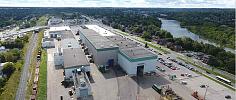Product Manager
- FMA
- The Fabricator
- FABTECH
- Canadian Metalworking
Should you perform your tool regrinding in-house?
Examine the economics before eliminating third-party grinding
- By Andreas Sommer
- August 29, 2019
- Article
- Metalworking

In-house tool and cutter grinding capability gives manufacturers the freedom to produce grinds quickly and improve effectiveness because the machine is on their own shop floor.
In-house or third-party? It’s a question that gets asked about many processes. While some procedures are obvious candidates for outsourcing, like heat treating and painting, tool grinding is a more difficult choice.
The regrinding industry is experiencing change. Regrinding or resharpening of high-performance cutting tools and drills is a cost-effective and environmentally friendly means of extending tool life. Resharpening is offered by tool service providers across numerous manufacturing industries, including automotive, aerospace, medical, and power generation.
Tool and cutter grinders are traditionally sold to cutting tool manufacturers and regrinding services, and these companies make up the largest market. However, in-house CNC tool grinding has become increasingly attractive to manufacturers that use a sizable volume of tooling.
Resharpening is driven by environmental responsibility and the need to reduce overall tooling cost. The cost to recondition a tool is generally lower than its replacement cost, and it is commonly understood that the resharpening process is typically less than half the cost of producing a new tool. When shops consider that an end mill can be reground at least three times, the numbers become even more compelling.
Tool service providers generally offer a high-quality, high-precision resharpened tool and aim to return its performance near to the original manufacturer’s specifications. However, the question becomes, When is it more attractive to in-source the resharpening of tool, not only from a cost perspective?
A large tool consumer can potentially save money by bringing reconditioning in-house. A bonus is the additional flexibility that comes with shorter turnaround times. Therefore, it is not just the cost of the tools that should be considered, but the loss of production if the right tool isn’t available when required. Machine shops can run into overly long regrinding times, especially when they use unusual geometries. In addition, the machine shop doesn’t need to carry excess backup inventory.
Today’s CNC tool grinders are easier to use than ever; conversely tools are more complex. While new technology has been introduced to automate mixed-batch regrinding to ensure the process is easy and effective, any company new to tool grinding still must build up in-house expertise.
In any case, it’s a big step, not only because investing in a tool and cutter grinder can be costly, but also because of the cost of grinding wheels, workholding, coolant, utilities, floor space, and, of course, an operator. A suitable CNC tool measuring machine will add to the setup expense.
While in-house tool and cutter grinding machine gives manufacturers the freedom to produce grinds quickly and improve effectiveness because the machine is on their own shop floor, adding in-house tool grinding typically requires a difficult investment decision.
As a result, the cost of outsourcing versus the investment needed to bring tool resharpening in-house needs to be compared on a case-by-case basis.

Machine builders that offer a variety of automated regrinding systems for mixed batches should be consulted to ensure the highest level of technology is implemented.
The business case
The cost of in-house regrinding depends on the utilization of the tool and cutter grinder. To be objective, a company must first determine the hourly rate of the investment. This includes the cost of depreciation, interest, floor space, energy, maintenance, and consumables. The cost of the operator is added based on whether the machine is run for one, two, or three shifts and if the machine has the capability to run unattended.
Based on the hourly rate and the estimation of cycle time per reground tool, a manufacturer is able to compare the base cost of in-house resharpening with outsourced services.
However, once a cost comparison is complete, it is important to evaluate the soft factors, such as:
- The cost of spares required to maintain production while tools are reground.
- The cost of outsourced resharpening per tool times the number of spindles needed in the machine shop.
- The turnaround/wait time and any possible cost of lost production caused by a delay in the outsourced regrinding service.
- Tool quality.
- The cost of associated processes (edge preparation, coating).
- Shipping costs.
Moving tool regrinding in-house also requires a company to have in-house expertise in this area. New technology can help by automating the process and even performing tool scanning.
Machine builders that offer a variety of automated regrinding systems for mixed batches – such as collet loading (when the tool and collet are changed at the same time) or changing with RFID -- should be consulted to ensure the highest level of technology is implemented.
With an RFID system, the required information is recorded at a programming station and the tool is coupled with the RFID tag. The machine picks up the tool together with the RFID tag, scans the RFID, and automatically calls up the grinding program. The RFID is parked while the tool gets loaded and reground.
By using RFID technology, manufacturers can load tools randomly into a loader pallet by creating an individual program for each tool. The tool position inside the pallet can be swapped with another tool anytime if a tool needs to be resharpened in a hurry.
The tool and cutter grinders can run the regrinding operation individually and unmanned; the duration of unmanned machine usage depends on the type of loader and the capacity of pallets.
ANCA and Zoller recently developed a means of reliable, error-free data transfer that automatically pre-sets the regrinding process. This includes the wear of the measured tool. Regrinding parameters are allocated to a corresponding pallet location when a tool loader is used. Once the tool is picked up by the loader and presented to the workholding, the automatic tool measurement system digitizes the tool. The measurement cycle has been developed to make regrinding a fast and simple operation. This cycle measures the most commonly required parameters for almost all tool types. Even a mixed batch of tools can be automatically loaded and reground.
Andreas Sommer is product manager for ANCA, 31129 Century Dr., Wixom, Mich. 48393, 248-926-4466, www.anca.com.
About the Author
subscribe now


Keep up to date with the latest news, events, and technology for all things metal from our pair of monthly magazines written specifically for Canadian manufacturers!
Start Your Free Subscription- Industry Events
MME Saskatoon
- May 28, 2024
- Saskatoon, SK Canada
CME's Health & Safety Symposium for Manufacturers
- May 29, 2024
- Mississauga, ON Canada
DiPaolo Machine Tools Open House 2024
- June 4 - 5, 2024
- Mississauga, ON Canada
FABTECH Canada
- June 11 - 13, 2024
- Toronto, ON Canada
Zoller Open House & Technology Days 2024
- June 12 - 13, 2024
- Ann Arbor, MI




















